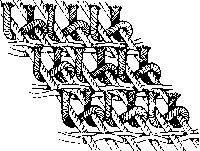|
|||||||||||||||||||||||||||||||||||||||||||||||||||||||||||
| |
|||||||||||||||||||||||||||||||||||||||||||||||||||||||||||
Technical Terms and InformationIn this section you can read up on oriental rug terminology, what to look for when purchasing an Oriental rug, an interesting article about the current state of carpet weaving in Iran and a listing of American Rug Societies that can be reached by email. A journalist friend of ours covered the Afghani war from the side of the rebels. You can read an excerpt from his book, Holy Blood. Oriental Rug TermsAbrash - Dye lot changes in the yarn show up as a different shade of color in the rug. Subtle abrash in tribal or village rugs enhances the folk art look. Major abrash in workshop rugs is considered a defect in dye control. Edge wrap - The side of the rug are wrapped with thick yarn to secure the outer edges. This should be done during the weaving process. Interlacing - Atiyeh rugs use a multi-color wool yarn interlaced within the flat selvage at two ends. The purpose is function, not form. Years into the future (75-100), if the fringe is worn away by use, this interlace will secure selvage and alert the new owner it is time to overcast this area or refringe the rug. Think of this as a long-term warning light. Lines - Some mass produced Chinese rugs graded by line count which indicates the number of knots per lineal foot. For other characteristics of rug quality you should consider the variables of wool quality, weaving construction, pile height or the number of top colors. Kerman - A city and province in Southeastern Iran where Atiyeh rugs were first produced. The name Kerman also refers to our design style of rugs we now produce in China. Nap - Rugs have nap direction caused by the knotting direction. Often a tightly knotted rug will look light at one end and dark from the other end. Pile - The cumulative cut ends of the knot result in pile or body of the rug. Most rugs have wool pile, while some have silk or a combination of silk and wool pile. Raj - Iranian rugs use a knot count based upon raj. This is the number of lineal knots in 7cm. Root names - When Persian designs are produced in China the word Sino precedes it in a description e.g.: Sino-Persian. If a Kerman design is produced in China it is called Sino-Kerman. The same is true with other countries' production such as India, when Indo precedes the descriptive name.
Weft - Cross threads are placed between warp threads after a row of knots is tied securing the knots. Atiyeh rugs use a thin weft followed by a thicker weft. This section continues with an explanation of what to look for when purchasing an Oriental Carpet. |

